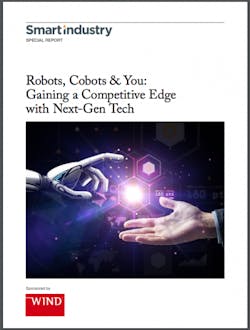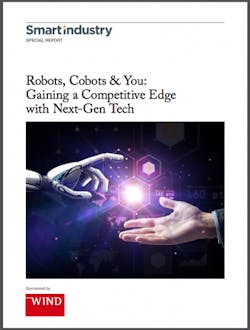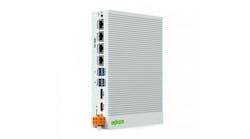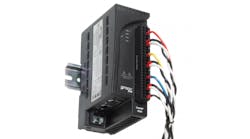By Gareth Noyes, chief strategy officer, SVP strategy & corporate development at Wind River
Cobots.
The name is a union of “collaborate" and "robot” and the increasing popularity of these autonomous machines in the manufacturing space is a result of the benefits of that collaboration. Like never before, robots are working with—oftentimes alongside—human counterparts. And they’re changing the modern industrial workplace.
Wind River's Gareth Noyes
Historically, industrial robotic applications deployed at scale have been geared towards mass production. In these scenarios the (historically expensive) robots are optimized for a specific task that can be carried out independently. These robots are normally physically isolated from people for safety, often by barriers or cages. Think of an assembly line which might have a robot that lifts and places material, another robot that can perform high speed and precise welds, and another that can paint beautiful blemish-free surfaces. These are traditional industrial robots. Steer clear!
Contrast this with cobots designed to assist or augment the capability of flesh-and-bone workers, whether guided by—or responding to—humans interacting with them to perform tasks jointly. These cobots share the same workspace as humans, interact with people (both deliberately or randomly), and move independently of their human co-workers. At the core of this newfound adaptiveness and responsiveness are increased levels of automation and a focus on enhanced safety considerations.
For the foreseeable future, these two distinct classes (robots, cobots) will likely remain, as there is additional cost and overhead in implementing the advanced capabilities of cobots. New skills come at a cost. As technologies mature and price-points reduce, however, it is likely that the distinction will become more and more blurred.
So what’s prompting this shift toward collaborative robots?
The factors are as varied as the tasks they can perform, enabled by emerging technologies (new computing power, cheap sensors, complex software) and propelled by business and personnel needs.
Business drivers boil down to efficiency (cost reduction or increases in throughput) or flexibility (moving from high volume/mass production to customized high mix/low-volume production).
Personnel factors include the demand for safe working environments (assisting workers in manipulating objects that could injure them), shortage of personnel with specific skills, and geo-political factors such as on-shoring.
Progressive business leaders are capitalizing on new capabilities afforded by cobotics—capabilities that were not possible with traditional robots—and optimizing efforts on both the business and personnel fronts.
Meet your new coworker. (He doesn’t talk much.)
Production environments are the easiest way to envision how human workers are collaborating with robots. While material handling on a production line works well with traditional robots (be the materials as small as a computer chip or as large as an automotive chassis), some tasks, such as installing wire looms in cars, require both might and finesse. In such a scenario, collaborative robots assist workers by supporting the heavy weight of cables being installed, while responding to guidance from humans for detail work and placement.
Human judgement—an essential workplace asset that isn’t going anywhere anytime soon—can be combined with automated tasks that improve precision, reduce errors and mitigate injuries.
If those benefits sound like significant ROI elements, you are correct.
Next-gen cobots
Robots have historically been employed for automating tasks. The distinction with cobots is that we are using these “next gen” machines to execute tasks autonomously. That’s an important distinction. While an RTOS like VxWorks is used as a robot’s software “brain,” software governing cobots must be expanded to ensure a higher level of safety and to enable the addition of further intelligence to increase machines’ freedom, range of motion and number of sensors that prompt the machine to respond to its surroundings.
While these underlying technology elements will have to be built into the system,
This article appears in the Special Report "Robots, Cobots & You"
ultimately it is the ability to make a more flexible and responsive system that will define the cobot as being “next gen.” Here we rely on advances in machine learning related to object recognition or problem solving, in addition to basic, reliable, safe control functions.
All of this changes the underlying software architecture required to build cobots. Here at Wind River, this entails a combination of traditional embedded technologies, such as VxWorks, working in tandem with general-purpose computing environments, such as Linux, to enable a modern approach to programming and the deployment of new technologies such as Tensorflow or OpenCV for machine learning and image processing.
Cobot educators
This is all heady stuff. New to many, even the smartest minds in industry. So there remains a great deal of confusion about cobot implementation in the manufacturing world. How do they work? What do they cost? How would my enterprise benefit from some newfangled machine that controls itself?
While the capabilities of modern robotics are generally well-understood among business leaders, the accessibility and availability of cobot systems isn’t. The perceived complexity can be overwhelming. There might be a lack of skills to make use of and deploy these systems (though a pool of talent for outsourced help is increasingly available). Another aspect is affordability, which becomes better year after year.
These factors must be communicated to executives pondering cobot initiatives. They are common concerns with attainable solutions. Ultimately deployment of cobots is most often limited by a compelling business case to do so. And in high-volume markets (consumer electronics, automotive manufacturing) there are compelling opportunities to do so. Flexible manufacturing, where consumers can customize their sneakers or their entire car, rounds out the other end of the spectrum; cobots and higher degrees of flexible manufacturing can drive real benefits. Naturally, large enterprises with deep pockets are implementing robotic infrastructure at a faster clip than smaller businesses lacking the domain knowledge to be early adopters.
Cobots 101
We at Wind River are happy to play the role of educator—Cobots 101. While our customers (OEMS, system integrators) oftentimes educate end users on how and when to deploy cobots, our role is to showcase how to easily implement and deploy the underlying technologies and software to enable the creation of autonomous systems featuring cobots. As with all advances in technology that have the potential to impact humans, demonstrating how to create systems that are secure, safe and reliable is paramount. Wind River can rely on 35 years of doing just that.
Reaping the greatest (collaborative) rewards
As I mentioned, industries that are driven by mass-market applications are most aggressively leveraging advanced robotics currently. Cobots and the democratization of intelligent-autonomous systems is enabling those agile, customizable manufacturers to get in the game, reaping benefits from robotic systems that will only grow more collaborative, more lucrative over time.
Traditional manufacturing sectors such as consumer and automotive sectors will dominate this trend in the short-term, but the drive to flexible, optimized supply chains will soon make robotics/cobotics more prevalent across industries; consider niche applications like search-and-rescue or emergency response to situations such as toxic spills that will emerge as a result of the growth of intelligent, collaborative robotic systems.
Now, while it is tempting (and fun) to ponder new features and capabilities of cobotics, the true mark of success will be the increased deployment of autonomous systems that drive unforeseen flexibility and productivity, all while making the workplace safer. (See my colleague Ricky Watts’ deep dive into safety later in this report.)
I am thrilled to see the spill-over of robot/cobot technologies and knowhow across applications. Just consider the recent explosion of artificial intelligence as a practical tool! I am excited about a future where robots and cobots provide us exponentially productive industrial environments that boast unprecedented safety.
And as we progress down this path, the distinction between the two terms should fade as collaboration between man and machine evolves. In fact, that term—cobot—might just replace its predecessor entirely.
“Hey boss,” asks the new employee on the factor floor of the near future, where autonomous cobots seamlessly work alongside him, “What was a robot?”





